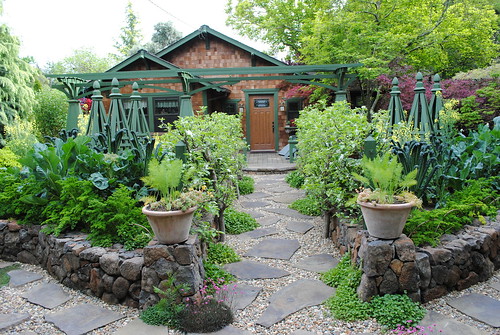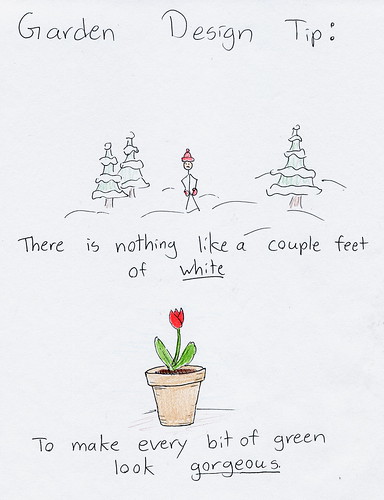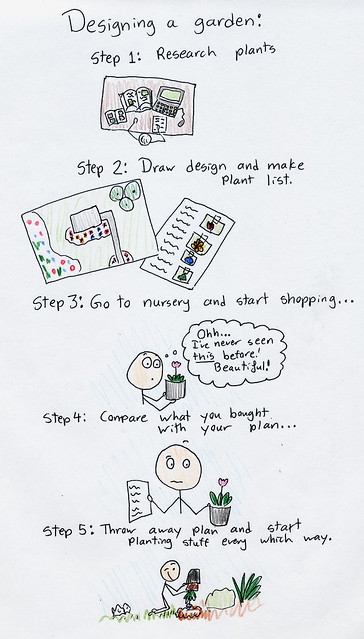Before I opened this book I knew two things: It would be beautiful, and it would be fun. Anyone who has read Ivette's blog,
The Germinatrix, would expect the same. Ivette's prose, like her gardens, is unabashed, exuberant, and a rollicking good time. And in terms of visual beauty, even my high expectations were blown away... This book is GORGEOUS. If you have any doubts that vegetables can be beautiful, the lush sensual photographs in this book will change your mind. I want half of them framed.

One of the gorgeous edible gardens in the book... WANT!
I was curious, though, on the practical front. This is a book about growing beautiful fruits and vegetables as an integrated part of a front yard display garden. Ivette knows her stuff, but she lives in Southern California, while I live in Michigan. Would anything actually apply to me in my garden?
Practical How-To
The first thing I did was flip to the practical sections – Chapters 6 through 10 go over the mechanics of planning, hardscaping, maintaining, and harvesting an edible ornamental garden. I had no need to be worried. The principles covered are solid, fundamental, and universal. Beginning gardeners will still need a good local book (or wise mentor) to school you in the vagaries of your particular climate, but this book covers most of the basics, and helps you know what questions you need to ask about where you garden now.
Beyond the usual talk of irrigation, compost, and harvest, I was thrilled to find detailed information for DIY hardscaping. Lovely paths, patios, and raised beds are a key part of any ornamental garden, edible or not, but so many garden design books simply assume you'll be hiring someone else to install them. Ivette recognizes that not everyone has that kind of budget, and gives great, clear, economical instructions on doing it yourself. I'm inspired now, and this summer I am finally putting in that patio I've been wanting!
In the garden maintenance chapter, I had minor quibbles with the confusion of the terms “chemical” and “synthetic” (organic fertilizers are still chemicals) and the assumption that everything organic is safe. My only major concern is that she doesn't address lead contamination. The soil near older homes and roads are frequently contaminated with lead from old lead paint and the exhaust from leaded gasoline. Before you plant anything you are going to eat in a hell strip or next to your house, GET A SOIL TEST. Lead poisoning is a serious risk, especially for children.
Designing the garden
The true brilliance of this book, however, is the chapters on design. Design is a very hard thing to teach. So many designers work by instinct, on a subconscious level, and can't really explain HOW they create the things they do. In my experience, books on design tend to be too specific (Plant in threes or fives ALL the time!) or too vague (Do what makes you happy!) or get bogged down in silly, artificial discussions of nonsensical things like the “color wheel” that don't really apply to how anyone I know actually designs a garden (or anything else for that matter)
 |
| Pretty, but I don't think it actually MEANS anything... |
I should have known Ivette would get it right. She guides you through considering your personal style, the look of your house, your neighborhood, and your city to create a garden that evokes the feel you want. One specific suggestion that I am TOTALLY going to start using, is called a mood board – basically using a cork board to brain-storm colors, textures, plants, and hardscaping. Maybe designer-types all have heard of this, but it is new to me, and I love it.
A great example of Ivette's way of teaching design is her take on the much-discussed rules of how many of each plant to use. She explains how different numbers work visually, then ends with perhaps the most perfect “rule” I've ever heard: “Play – but play with big numbers”
That is the tone of this entire book – Ivette gives you the basic guidelines and concepts you need to be successful, and then points you to developing the personal, creative style that you will enjoy and reflects your individuality.
In short, this is a terrific, gorgeous, book about growing ornamental vegetables – but at its heart, it is a spectacular, inspiring book on garden design -- of any kind. Even if you have no interest in growing food, you should read this book. It will inspire you to be a better designer, and the absolutely gorgeous shots of artichokes, chard, and purple-leaf basil will probably convince you to grow them even if you don't like how they taste.
Full disclosure: I received a copy of this book for free to review.














































